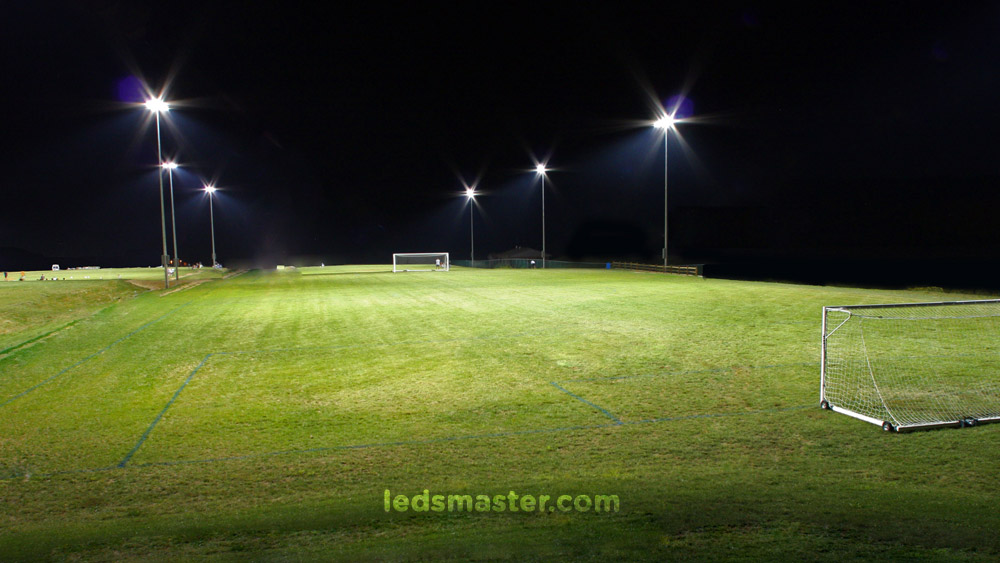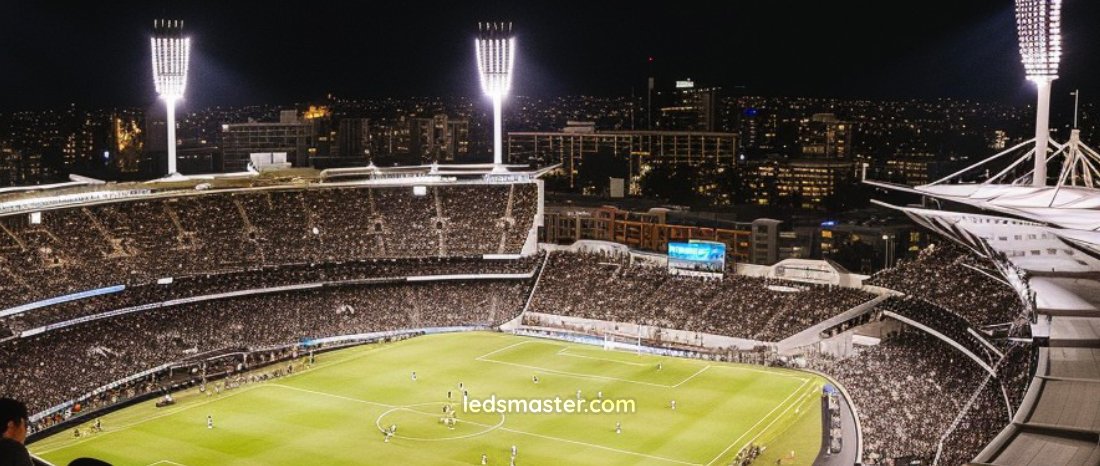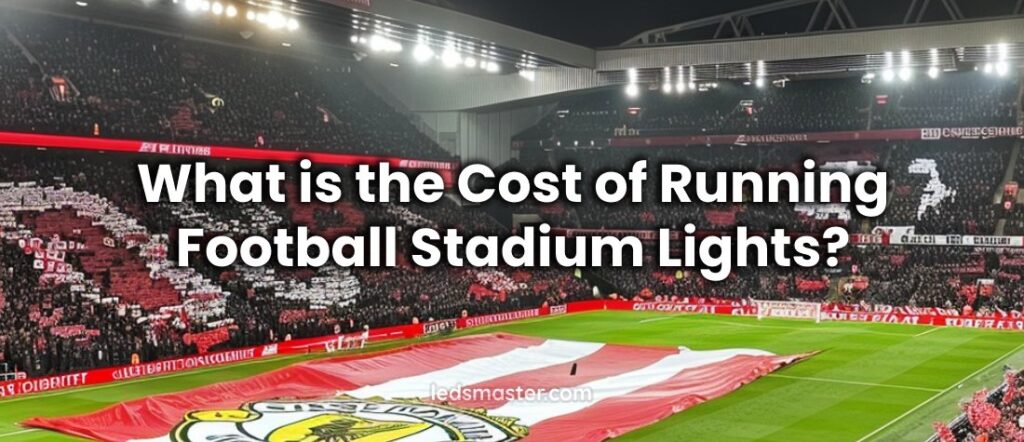Football stadiums are iconic structures that come alive under the glow of floodlights during evening matches. However, beyond the spectacle lies a significant operational cost associated with lighting these venues. The energy required to illuminate a football stadium can be substantial, impacting both the environment and the finances of the clubs and organizations that manage them. This article explores the various factors that contribute to the cost of running football stadium lights, with a primary focus on energy consumption.
Table of Contents
ToggleUnderstanding Running Cost of Stadium Lights
The cost of running stadium lights is primarily determined by the energy consumption, which is measured in kilowatt-hours (kWh). The formula to calculate energy cost is straightforward:
Energy Cost = Power (kW) × Hours of Use × Cost per kWh
- Power (kW): This refers to the total power consumption of all the stadium lights combined. For example, if a stadium has 100 fixtures each rated at 2 kW, the total power consumption would be 200 kW.
- Hours of Use: The number of hours the lights are operational during matches, training sessions, and other events.
- Cost per kWh: The cost of electricity varies by location and can fluctuate based on demand, time of day, and other factors. Industrial and commercial rates often differ from residential rates and can include demand charges and other fees.

Let’s examine a typical recreational football stadium as an example. Assuming the average electricity usage of LED football field floodlights is approximately 16,000 watts, equivalent to 16 pieces of 1000 watt LED floodlights. The cost calculation for running these lights is as follows: 16,000 watts x 8 hours x $0.15 ÷ 1000 = $19.2 per day. Thus, operating the lights on a recreational football or soccer field for 8 hours daily results in a daily cost of approximately $19.20, totaling $576 per month. It’s important to note this cost pertains specifically to LED lights. If using metal halide or halogen lights, the expenses would be considerably higher.
For instance, achieving the same illumination with metal halide lamps would require around 35,000 watts. Consequently, the cost to operate the stadium lighting would be 35,000 watts x 8 hours x $0.15 ÷ 1000 = $42 per day, or $1,260 per month. By switching from metal halide to LEDs, monthly savings can amount to approximately $1,260 – $576 = $684, equating to $8,208 annually. Given that LEDsMaster’s LED lights have a lifespan of at least 35 years, potential savings on operating costs could reach up to $8,208 x 35 years = $287,280.
| Type of football fields | Daily running cost of LED football field lights | Monthly running cost (LED) | Annual running cost (LED) | Annual running cost (Metal halide) |
| Amateur or recreational football field | $19.2 | $576 | $6,900 | $15,000 |
| High school football stadium | $36 | $1,080 | $12,960 | $28,300 |
| Professional stadium (e.g. FIFA stadium) | $240 | $7,200 | $86,400 | $189,000
|
Based on the table provided, it’s evident that the most extreme scenario shows a yearly running cost difference of approximately $100,000 for football stadium lighting. LED lights prove to be highly energy efficient, requiring lower wattage to illuminate the entire stadium, which translates into substantial savings both in energy consumption and associated costs. Opting for LED lights is clearly the more economical choice, offering significant financial benefits.
Aside from the initial cost of stadium lighting fixtures, it’s crucial to consider ongoing operational expenses, which constitute the primary expenditure for stadium lighting. While metal halide lights may have a lower upfront cost compared to LEDs, their higher operational expenses impose a significant financial burden on stadium budgets. Despite the initial investment being slightly higher for LED football floodlights, their operational costs are markedly lower in the long run.
Influential Factors on the Running Costs of Stadium Lights

Type of Lighting Technology
When it comes to stadium lighting, two primary technologies have dominated over the years: high-intensity discharge (HID) lights, specifically metal halide, and the more contemporary light-emitting diode (LED) lights. Each technology brings distinct advantages and considerations to the table.
High-Intensity Discharge (HID) Lights
High-intensity discharge lights, particularly metal halide lamps, have long been the stalwart choice for illuminating football stadiums. Known for their powerful brightness and relatively good color rendering index (CRI), metal halide lights effectively light up large areas. They operate by passing an electric arc through a mixture of gases, creating an intense light output. Historically, these lights have been favored for their ability to illuminate vast spaces evenly, crucial for maintaining visibility during evening matches.
However, despite their effectiveness, metal halide lights come with drawbacks. They are energy-intensive, converting a significant portion of the electricity they consume into heat rather than light. This inefficiency not only drives up operational costs but also contributes to higher cooling requirements in enclosed stadiums. Furthermore, metal halide lamps have relatively short lifespans compared to LEDs, typically requiring replacement every few years, which adds to maintenance costs.
Light-Emitting Diode (LED) Lights
In recent years, the landscape of stadium lighting has been revolutionized by the advent of light-emitting diode (LED) technology. LED lights offer a plethora of advantages that are reshaping the industry standards:
Energy Efficiency
LEDs are renowned for their exceptional energy efficiency. They convert a higher percentage of electrical input into visible light, minimizing wasted energy and reducing electricity bills. This efficiency is particularly crucial for stadiums, where the sheer number of fixtures and hours of operation can lead to substantial energy consumption.
Longevity
One of the standout features of LED lights is their extended lifespan. LEDs can operate for tens of thousands of hours before needing replacement, significantly reducing maintenance costs and downtime associated with re-lamping. This durability is especially advantageous in stadiums, where accessing and replacing high-mounted fixtures can be challenging and costly.
Instant On/Off and Dimming Capabilities
LEDs offer instant illumination without the warm-up time required for HID lamps. They also integrate seamlessly with advanced lighting control systems, allowing for precise dimming and scheduling. This flexibility not only enhances energy savings but also enables stadiums to adjust lighting levels dynamically during events or practices.
Directional Lighting
LED technology allows for more precise control over the direction and distribution of light. This capability helps minimize light spillage beyond the playing field, enhancing visibility for players and spectators while reducing light pollution in surrounding areas.
Power Rating and Number of Fixtures
The efficiency and effectiveness of stadium lighting are intricately tied to the power rating of individual fixtures and the total number of fixtures installed. These factors play a crucial role in determining the energy consumption and operational costs associated with lighting up a football stadium.
Power Rating
The power rating of each light fixture is a fundamental determinant of its energy consumption and lighting capability:
Electrical Power (Watts or kW)
The power rating indicates the amount of electrical energy consumed by each fixture when illuminated. It directly influences the brightness and intensity of the light emitted. Higher-wattage fixtures typically produce more lumens (brightness) but also consume more electricity per unit of time.
Brightness and Illumination Levels
In stadium lighting, achieving adequate illumination levels across vast seating areas and playing fields is essential for player performance and spectator experience. Higher power-rated fixtures are often necessary to ensure uniform lighting and visibility, especially in larger stadiums with expansive seating capacities.
Energy Efficiency Considerations
While higher power-rated fixtures may be required for sufficient illumination, advancements in lighting technology, particularly with LEDs, have significantly improved energy efficiency. LED fixtures can produce high lumen output while consuming less energy compared to traditional HID lights like metal halide, thereby reducing overall operational costs.
Heat Generation: One drawback of higher power-rated fixtures, particularly with traditional HID lamps, is the generation of excess heat. This not only contributes to increased cooling requirements but also reduces overall energy efficiency as a significant portion of electrical input is converted into heat rather than light.
Number of Fixtures
The total number of fixtures installed in a stadium directly impacts energy usage and lighting performance:
Coverage and Uniformity
Larger stadiums with higher seating capacities and expansive playing fields require a greater number of fixtures to achieve uniform lighting coverage. The distribution and arrangement of fixtures play a crucial role in minimizing shadows and ensuring consistent illumination across all areas visible to players and spectators.
Operational Flexibility
The number of fixtures installed determines the stadium’s capacity to adjust lighting levels based on specific events, such as matches, training sessions, and non-sporting events. Flexibility in lighting control allows stadiums to optimize energy usage by activating only necessary fixtures and adjusting brightness levels as needed.
Total Power Consumption
The cumulative power consumption of multiple fixtures operating simultaneously during peak usage times, such as evening matches or events, can be substantial. Stadium operators must consider the aggregate energy demand of all fixtures to accurately estimate electricity costs and plan for sustainable energy management practices.
Maintenance and Replacement Costs
Beyond energy consumption, the number of fixtures also influences maintenance and replacement schedules. LED fixtures, known for their extended lifespan compared to traditional HID lights, reduce the frequency and cost of replacement, thereby contributing to long-term operational savings.
Balancing Efficiency and Performance
Achieving optimal lighting in football stadiums requires a careful balance between energy efficiency, performance requirements, and operational costs:
Technology Advancements
The shift from conventional HID lights to LED technology represents a significant advancement in stadium lighting. LEDs offer superior energy efficiency, longer lifespan, instant illumination, and precise control capabilities, making them an ideal choice for modern stadiums looking to enhance sustainability and reduce operating expenses.
Lighting Design and Planning
Effective lighting design considers factors such as fixture placement, beam angles, and light distribution to maximize efficiency and minimize energy waste. Advanced lighting simulations and photometric analyses help optimize lighting layouts to achieve desired illumination levels while minimizing glare and light spillage.

Environmental Considerations
Carbon Footprint
Energy consumption in stadiums directly correlates with greenhouse gas emissions, making it a significant contributor to climate change impacts. The choice of lighting technology plays a crucial role in mitigating these environmental effects. Traditional lighting technologies, such as high-intensity discharge (HID) lamps like metal halide, are notorious for their inefficiency in converting electrical energy into visible light. This inefficiency not only results in higher energy bills for stadium operators but also translates into increased carbon emissions from the electricity generation process.
LED (light-emitting diode) lights, on the other hand, have emerged as a transformative solution in reducing stadiums’ carbon footprints. LED technology boasts significantly lower energy consumption compared to traditional HID lamps. LEDs are highly efficient, converting a larger percentage of electricity directly into light while minimizing wasted energy as heat. This efficiency not only results in cost savings for stadium operators but also reduces the overall demand for electricity from the grid.
The environmental benefits of LED lights extend beyond energy efficiency. By lowering energy consumption, LEDs help reduce the greenhouse gas emissions associated with electricity generation, which is predominantly sourced from fossil fuels in many regions. This reduction in carbon emissions contributes positively to global efforts aimed at combating climate change and transitioning towards a more sustainable future.
Sustainability Efforts
In response to global imperatives for sustainability, many stadiums worldwide are undertaking significant investments in renewable energy sources, particularly through the installation of solar panels. This strategic shift aims to offset substantial electricity consumption typically associated with stadium operations, including lighting, HVAC systems, and other amenities crucial for hosting events and maintaining spectator comfort. By harnessing solar energy, stadiums not only reduce their environmental footprint but also align themselves with evolving regulatory standards and sustainability goals in various regions.
Cost Management Strategies
To mitigate the cost of running stadium lights, clubs and organizations employ various strategies.
Energy Audits
Conducting regular energy audits stands as a cornerstone of proactive energy management strategies for stadiums aiming to enhance efficiency, reduce operational costs, and align with sustainability goals. These audits are instrumental in systematically evaluating a stadium’s energy consumption patterns, identifying inefficiencies, and pinpointing specific opportunities for improvement, such as upgrading to more efficient lighting systems and optimizing usage schedules.
Lighting Controls
Installing advanced lighting control systems represents a significant advancement in stadium management practices, offering operators the ability to optimize energy usage and enhance operational efficiency. These systems enable precise adjustment of light levels based on specific requirements, effectively reducing energy consumption during off-peak hours or when the stadium is not at full capacity. This proactive approach not only contributes to cost savings but also aligns with sustainability goals by minimizing unnecessary energy use and reducing environmental impact.
Financial Planning
Understanding and effectively budgeting for energy costs is fundamental for ensuring financial stability and operational efficiency within football clubs and stadiums. With energy expenditures often constituting a significant portion of operational expenses, clubs must adopt proactive strategies to manage and mitigate these costs. This includes negotiating energy contracts, exploring energy-saving incentives, and leveraging rebates offered by utility providers.
Conclusion
The cost of running football stadium lights is a significant operational expense driven by energy consumption. This article has explored how choices in lighting technology, such as LED versus traditional HID lights, impact both financial expenditures and environmental considerations. By adopting energy-efficient upgrades and implementing advanced lighting controls, clubs can not only reduce costs but also align with sustainability goals and regulatory requirements. Managing energy expenses effectively through proactive measures is crucial for ensuring financial stability and promoting responsible resource management in sports venues globally.

